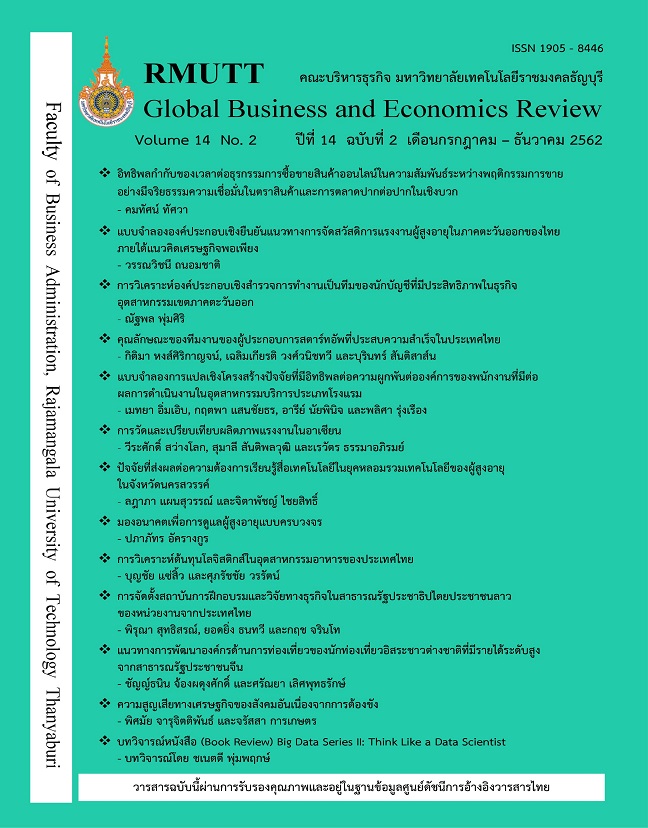CHARACTERISTIC OF TEAM IN SUCCESSFUL STARTUP ENTREPRENEUR IN THAILAND
Keywords:
Characteristic of Team, Entrepreneur, StartupAbstract
This research studied the characteristic of team in successful startup business through documentary research and qualitative research. The changing in business management impacted on the people management within organization. In the past, the organization management focused on how to set the system, create the standard structure as a whole, manage the people through manager and staff relationship. However, the new way of running the business under Thai’s Government support named “Startups” required a new way of managing people as a leader and team. This business required a competent person who not only had skills, creativity, and being a good problem solver but also could work as a team. The literature review showed that the characteristics of successful team included communication skills among team and leader, loyalty and commitment; and the same direction and trust among team member. After the researcher had employed qualitative research by in-depth interview of 32 people and a focus group of 7 people, the results showed that all characteristics mentioned above were all relevant for successful team member. However, a new finding, initiative, was also discovered. Consequently, this research could be concluded that the conceptual framework of successful startup team member in Thailand was associated with 5 characteristics factors: communication, loyalty and commitment, the same goal and direction, trust and initiative.
References
บวร เทศารินทร์. (2560). ประเทศไทย 4.0 อะไร ทำไม และอย่างไร. เข้าถึงได้จาก https://www.drborworn.com/articledetail.asp?id=16223
มหาวิทยาลัยหอการค้าไทย. (2560). Start Up คืออะไร. เข้าถึงได้จาก https://gs.utcc.ac.th/mk/0000%20566-59/c13/1%20Articles%20-%20Startup-A-.pdf.
Barrick, M. B., Bradley, B. H., Kristof-Brown, A. L., & Colbert, A. E. (2007). The moderating role of top management team interdependence: Implications for real teams and working groups. Academy of Management Journal, 50, 544-557.
Bishop, J. W., Scott, K. D., & Burroughs, S. M. (2000). Support, commitment, and employee outcomes in a team environment. Journal of Management, 26(6), 1113-1132.
Blank, S. (2017). Why the lean start-up changes everything. Harvard business review. Retrieved from https://hbr.org/2013/05/why-the-lean-start-up-changes-everything
Burns, J. M. (2003). Transforming leadership: a new pursuit of happiness. Vol. 213. New York: Grove Press.
CBINSIGHTS Research. (2017). The top 20 reasons startups fail. USA: CBINSIGHTS. Retrieved from https://www.cbinsights.com/research/startup-failure-reasons-top/
Davila, A., Foster, G., & Gupta, M. (2003). Venture capital financing and the growth of startup firms. Journal of business venturing, 18(6), 689-708.
Frese, M., & Fay, D. (2001). 4. Personal initiative: an active performance concept for work in the 21st century. Research in organizational behavior, 23, 133-187.
Gladwell, M. (2013). David and Goliath: underdogs, misfits, and the art of battling giants. New York : Little, Brown and Company.
Graham, P. (2012). Want to start a startup? get funded by Y combinator. Retrieved from https://www.paulgraham.com/growth.html
Kesen, M. (2016). Linking organizational identification with individual creativity: organizational citizenship behavior as a mediator. Journal of Yaşar University, 11(41), 56-66.
Langfred, C. W. (2004). Too much of a good thing? negative effects of high trust and individual autonomy in selfmanaging teams. Academy of Management Journal, 47, 385-399.
Lencioni, P. (2006). The five dysfunctions of a team. New Jersey: John Wiley and Sons.
Liborius, P. (2014). Who Is worthy of being followed? the impact of leaders’ character and the moderating role of followers’ personality. Journal of Psychology, 148(3), 347-385.
Mayer, R. C., Davis, J. H., & Schoorman, F. D. (1995). An integrative model of organizational trust. Academy of Management Review, 20, 709-734.
Muñoz-Bullon, F., Sanchez-Bueno, M. J., & Vos-Saz, A. (2015). Startup team contributions and new firm creation: the role of founding team experience. Entrepreneurship and Regional Development, 27(1-2), 80-105.
Peterson, S. J., Walumbwa, F. O., Byron, K., & Myrowitz, J. (2009). CEO positive psychological traits, transformational leadership, and firm performance in high-technology start-up and established firms. Journal of management, 35(2), 348-368.
Robinson, A. B. (2012). How to follow the leader. Christian Century, 129(1), 30-33.
Schneider, B. (1987). The people make the place. Personnel psychology, 40(3), 437-453.
Solovy, A. (2005). Followership. HandHN: Hospitals and Health Networks, 79(5), 32.
Startup Thailand Center: National Innovation Agency. (2561). สมคิดสั่งตั้งงบหมื่นล้านปั้นสตาร์ทอัพฮับ. เข้าถึงได้จาก https://www.startupthailand.org/somkid-orders-b10bn-spent-on-startup-fund-th/
Techsauce. (2017). Thailand Tech Startup Report Q1 2017. เข้าถึงได้จาก https://techsauce.co/report/thailand-tech-startup-ecosystem%E2%80%8B-q1-2017/
Van Der Vegt, G. S., & Bunderson, J. S. (2005). Learning and performance in multidisciplinary teams: The importance of collective team identification. Academy of management Journal, 48(3), 532-547.
Ye, D., Ng, Y. K., & Lian, Y. (2015). Culture and happiness. Social indicators research, 123(2), 519-547.
Yukl, G., Gordon, A., & Taber, T. (2002). A hierarchical taxonomy of leadership behavior: Integrating a half century of behavior research. Journal of Leadership and Organizational Studies, 9(1), 15-32.
Downloads
Published
How to Cite
Issue
Section
License
The articles published in this journal are the intellectual property of their respective authors.
The views and opinions expressed in each article are solely those of the individual authors and do not reflect the positions of Rajamangala University of Technology Thanyaburi or any of its faculty members. All components and content of each article are the sole responsibility of the respective authors. In the event of any errors, the authors shall bear full responsibility for their own work.








